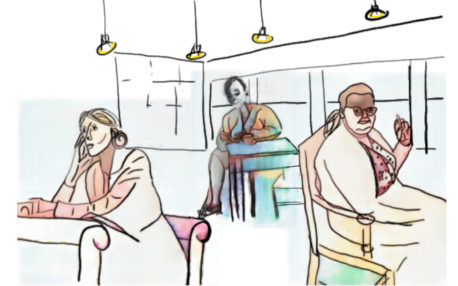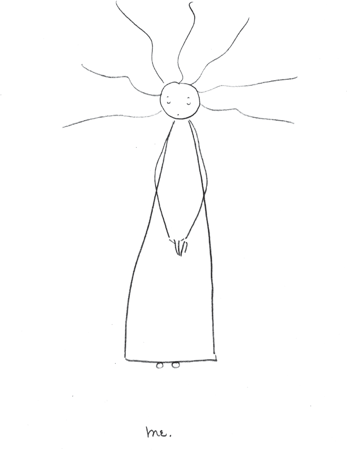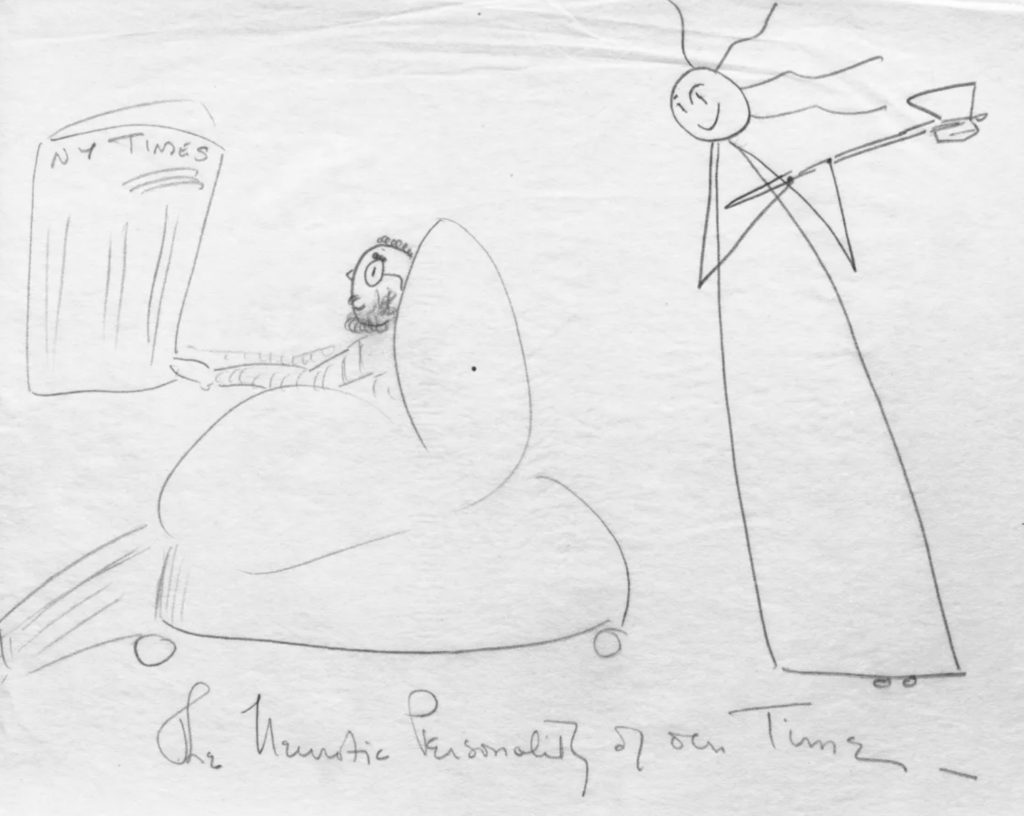Just an ordinary day
Shirley wore a dark brown cardigan over a plain cotton dress and sensible shoes to carry the weight of the words she wanted to write. With four children to raise, she hadn’t had time to make herself look pretty or straighten her lipstick on just an ordinary day.[1] Shirley Jackson, 1996, ‘One ordinary day, with Peanuts’ in Just an Ordinary Day, p. 365.
Virginia wore a large dark navy pin-striped coat[2]I learned about Virginia’s love of this style of coat after reading Claire Nicholson’s 2012 essay “But Woolf was a sophisticated observer of fashion…: Virginia … Continue reading over a white floral flecked shirt tucked neatly into a high-waisted black skirt. She hated being badly dressed but hated buying clothes [3](Virginia Woolf, 1985, Moments of Being, p. 210. and in her haste to work as she walked[4]Virginia Woolf, 1965, A Writer’s Diary, p. 183., had pulled on a pair of thick orange woollen stockings.
Elizabeth wore a dark pink t-shirt with ruffled sleeves on top of a red tweed miniskirt, and a pair of perfectly matched red, pink, and orange pumps. She hoped no-one would notice that one of the red buttons adorning one of the front pockets had gone astray.

Surprise is like a thrilling – pungent –
Upon a tasteless meat
Alone – too acrid – but combined
An edible delight
Emily Dickinson [5]Emily Dickinson, 1970, Poem #1306, The Complete Poems, p. 568.
My name is … and I am going …

My name[6]The naming and repetition of names draws inspiration from the character ‘Betsy’, one of four in a split personality in Shirley Jackson’s The Bird’s Nest, who takes comfort … Continue reading is Shirley Hardie Jackson[7]Shirley Jackson was fond of drawing black and white cartoon style sketches depicting aspects of her life. This image titled “Me”, is the one she chose to represent herself and her life. … Continue reading Shirley whispered, and I am 48 years old. I am going alone to the Rain Barrel café to write. I was born in Ashbury Heights San Francisco and my mother’s name is Geraldine Maxwell Bugbee and my name is Shirley. I am going alone to write, and I am going to put garlic in my fiction.[8]In a lecture Shirley Jackson gave on writing fiction, she advised that in order to grab even the most lazy reader’s attention, a writer should consider using adjectives, images and symbols … Continue reading
My name is Adeline Virginia Woolf, Virginia whispered, and I am 59 years old. I am going alone to Maison Bertaux café to write. I was born in South Kensington, London and my mother’s name is Julia Prinsep Jackson and my name is Virginia. I am going alone to write, and I am going to make my words into a double-layered cottage loaf.
My name is Elizabeth Narelle Mackinlay, Elizabeth whispered, and I am 52 years old. I am going alone to Goodness Gracious café to write. I was born in Upper Ferntree Gully, Melbourne and my mother’s name is Lynette Helen Barlow and my name is Elizabeth. I am going alone to write, and I refuse to starve my writing any longer.
As she walked, Shirley’s mind ran with the beginnings of a short story. The main character, a bored suburban housewife called Margaret, watched her husband smoke a cigar and read the newspaper after dinner while she searched for reasons not to kill him. What a thought![9]‘What a Thought’ is a short story written by Shirley Jackson and published after her death in the 1996 short-story collected Just an Ordinary Day.
As she walked, Virginia’s mind followed the road cut by women writers many years ago and began to sketch a simple story. The main character, a promising young thing, her words cruelly haunted and halted by the Angel in her house[10]This very well-known Woolf spectre appears in her 1931 essay ‘Professions for Women’ https://www.literaturecambridge.co.uk/news/professions-women ., contemplated ways to despatch of her. “I acted in self-defence!” She would cry.
As she walked, Elizabeth felt compelled to run to escape the story that threatened to cut her life short. The main character, a man charming by name and by nature, threw words and weapons at her in equal measure. She stumbled on a crack in the footpath and refusing to fall shouted, “Enough!”
An ashtray, an inkpot and a diary
Shirley took a seat at a sloping round table on the very west side of the café and pulled out her notebook. Placing an ashtray in front of her, she lit a cigarette and returned to thoughts of Margaret. Was she brave enough to kill her husband? What would she do with his suits when he was dead?
Virginia took a seat in a vivid wingback armchair by the fire in the center of the café. Placing an inkpot on the coffee table beside her, she pulled out her purple inked quill and thought of the Angel in the house. Her rustling skirts and winged shadow would never permit the promising young writer to have a mind of her own—killing the wretched phantom would become her primary occupation.
Elizabeth took a seat on a white bentwood chair on the sunny side of the café. Placing her diary and black pen beside a hot cup of coffee, she contemplated the monster that terrorized her by night and day. Every morning she woke unsure whether she was relieved or regretful that he had not yet killed her.
Shirley tapped her fingers idly on the table. Margaret’s situation was nice and not unusual; she had a nice husband and a nice home, and she was kept by both nicely, and did as she was told nicely but no longer wanted to be nice.
Virginia tapped her fountain pen sleepily on the table. The young woman’s situation was growing tiresome—indeed, she was growing tired of the Angel telling her she could not write with her own mind and she was growing tired of being told by the Angel that she could not write this and she couldn’t write that.
Elizabeth tapped her foot nervously on the leg of the table. Her situation had reached a breaking point; she needed to make a break, but she was unsure if his hands or hers would finally break her.
The first idea is always the best

Shirley began to write[11]This sketch accompanies a letter sent to Shirley’s editor Carol Brandt on 14 October 1964 in which she describes the progress of a ‘nasty little story’ she was writing. The … Continue reading; it was time for Margaret to rid herself of her husband and fly the coop. While he was reading the paper, she told him she loved him then picked up the glass ashtray glittering in the light of the lamp and struck him on the head. The first idea is always the best.
Virginia began to write; it was time for the young woman writer to free herself from the Angel in the house. The next time the radiance of the Angel’s halo fell upon her page, the young woman writer picked up her inkpot and flung it at her as hard as she could. The struggle was severe but necessary.
Elizabeth began to write; it was time for her to run. Her running was interrupted by a telephone call from a police officer called Cathy. They had him safely behind bars, she shivered and turned her face toward the sun. She could stop running now.
How beautiful, how clever!
Shirley put out her cigarette and collected her things. She smiled; they could call her Virginia Werewoolf[12]A name given to Shirley Jackson by a reviewer in the Times, see Ruth Franklin, 2016, Shirley Jackson: A Rather Haunted Life, p. 453. if they liked, she didn’t care, in fact it she thought it was quite the compliment. She had always wondered what it would feel like to smash the patriarchy and now her Margaret had done it—clever girl!
Virginia dabbed the ink stains on her hands and gathered her things. She smiled; they could call her a negligible nincompoop[13]Virginia Woolf agonised over the reviews she received from critics on her work and on 29th October 1922 after the publication of Jacob’s Room, lamented the fickle nature of readers who were … Continue reading if they liked, she didn’t care, in fact, it added fuel to the flames that lit the lamp in her spine. She had imagined for some time what it would feel like to rid herself and her writing of the phantom of patriarchy and now the young woman had done it—how up to date and clever she was![14]A moment of self-praise on 12 April 1919, see Virginia Woolf, 1954, A Writer’s Diary, p. 12.
Elizabeth got to her feet and packed her things. She smiled; he could call her whatever names he liked from his 2 x 3-foot concrete cell, she didn’t care; in fact, the photograph she had placed of him in the freezer would be sure to render him silent. She hadn’t dared dream what her life would be like without him until now—it was time to lace up and hit the road running with her Woolf pack.
Shirley stepped outside onto Prospect Street and soaked in the cleverness of sunlight shining painfully straight from the sky through the pleasant arches of trees with tiny pink blossoms lining either side of the road.[15]Shirley Jackson provides the most vivid descriptions of suburban streets in the opening pages of The Road through the Wall, 1948, p. 7. How nice it is in North Bennington! She thought.
Virginia stepped outside onto Greek street and breathed in islands of light, the glossy brilliance of motor cars, and the brave abundance of bunches of blue and red flowers in florist’s windows. How beautiful London is! She thought.[16]In a similar vein to Shirley, Virginia took delight in finding ways to being the vividness of life in London to life in her writing. This particular imagery appears in her 1927 essay ‘Street … Continue reading
Elizabeth stepped outside onto Oxley Road and marvelled at the dappled tones of winter caressing her face, the delicate crumbling sound of the day passing and the way that this rare leaf and that danced softly in the branches of the trees above her. How wonderful Graceville is at this time of year! She thought.[17]This piece came to life while reading Ruth Franklin’s biography of Shirley Jackson – Shirley Jackson: A Rather Haunted Life – and Shirley Jackson’s collected of short stories … Continue reading
References
| ↑1 | Shirley Jackson, 1996, ‘One ordinary day, with Peanuts’ in Just an Ordinary Day, p. 365. |
|---|---|
| ↑2 | I learned about Virginia’s love of this style of coat after reading Claire Nicholson’s 2012 essay “But Woolf was a sophisticated observer of fashion…: Virginia Woolf, clothing and contradiction” in D. Ryan & S. Bolaki (Eds.), Contradictory Woolf (pp. 129–133). Liverpool University Press. |
| ↑3 | (Virginia Woolf, 1985, Moments of Being, p. 210. |
| ↑4 | Virginia Woolf, 1965, A Writer’s Diary, p. 183. |
| ↑5 | Emily Dickinson, 1970, Poem #1306, The Complete Poems, p. 568. |
| ↑6 | The naming and repetition of names draws inspiration from the character ‘Betsy’, one of four in a split personality in Shirley Jackson’s The Bird’s Nest, who takes comfort from reminding herself of who she is as searches the streets of New York lost and looking for her lost mother. |
| ↑7 | Shirley Jackson was fond of drawing black and white cartoon style sketches depicting aspects of her life. This image titled “Me”, is the one she chose to represent herself and her life. Her book of letters, The Letters of Shirley Jackson, includes reprints of her witty line drawings and “Me” appeared in a letter to her husband Stanley Hyman dated in 8th June 1938. |
| ↑8 | In a lecture Shirley Jackson gave on writing fiction, she advised that in order to grab even the most lazy reader’s attention, a writer should consider using adjectives, images and symbols sparingly – a technique she called “garlic in fiction”. See Ruth Franklin, 2016, Shirley Jackson: A Rather Haunted Life, p. 173. |
| ↑9 | ‘What a Thought’ is a short story written by Shirley Jackson and published after her death in the 1996 short-story collected Just an Ordinary Day. |
| ↑10 | This very well-known Woolf spectre appears in her 1931 essay ‘Professions for Women’ https://www.literaturecambridge.co.uk/news/professions-women . |
| ↑11 | This sketch accompanies a letter sent to Shirley’s editor Carol Brandt on 14 October 1964 in which she describes the progress of a ‘nasty little story’ she was writing. The nasty little story titled ‘The possibility of evil’ was published posthumously in 1965 and would win the Edgar Allan Poe Award for Best Short Story. See The Letters of Shirley Jackson, 2021, p. 583. |
| ↑12 | A name given to Shirley Jackson by a reviewer in the Times, see Ruth Franklin, 2016, Shirley Jackson: A Rather Haunted Life, p. 453. |
| ↑13 | Virginia Woolf agonised over the reviews she received from critics on her work and on 29th October 1922 after the publication of Jacob’s Room, lamented the fickle nature of readers who were either with her or against. See Virginia Woolf, 1954, A Writer’s Diary, p. 54. |
| ↑14 | A moment of self-praise on 12 April 1919, see Virginia Woolf, 1954, A Writer’s Diary, p. 12. |
| ↑15 | Shirley Jackson provides the most vivid descriptions of suburban streets in the opening pages of The Road through the Wall, 1948, p. 7. |
| ↑16 | In a similar vein to Shirley, Virginia took delight in finding ways to being the vividness of life in London to life in her writing. This particular imagery appears in her 1927 essay ‘Street Haunting’, see Selected Essays, 2009, p. 134. |
| ↑17 | This piece came to life while reading Ruth Franklin’s biography of Shirley Jackson – Shirley Jackson: A Rather Haunted Life – and Shirley Jackson’s collected of short stories Just an Ordinary Day. I had just finished reading ‘What a Thought’, and feeling at once horrified and enthralled by the possibility of evil that exists beneath the skin of any housewife behind the closed doors of domesticity, I found myself thinking of Virginia Woolf, rooms of one own and her essay ‘Professions for Women’. My imagination began running and soon made a connection between the way that Shirley’s character Margaret metaphorically smashes patriarchy with an ashtray and Virginia’s young writer picks up an inkpot to do the same. The delight for me was reading about the name given to Shirley Jackson by reviewers – Virginia Werewoolf – at almost precisely the same time I was thinking and wondering about the similarity of ashtrays and inkpots. Serendipity is indeed a wonderful thing and I decided to embrace it wholeheartedly to weave Shirley, Virginia and me together in a short story about their short stories and my own – three women writing in a cafe on just an ordinary day working their words to do quite extraordinary things. |
Very engaging read Liz, as you have woven each women’s story on the page…depicting the murderess rage that exists just below the surface … at the lack of appreciation for a women’s individual and collective value and worth as herself rather than a domestic object.
Thank you Dawne for sharing your thoughts on this piece – rage and delight for sure! Both Shirley and Virginia felt both intensely in equal measure, as do I do it would seem!
Thank you Liz for this beautifully crafted piece … like a basket made from braided sweetgrass (Robin Wall Kimmerer). It was really evocative and delicious to my senses x
I absolutely love this Liz! The three stories told together in one like this worked so well. Three different women in three different circumstances find themselves in the same battle with patriarchy. I’m off to find my ink pot…